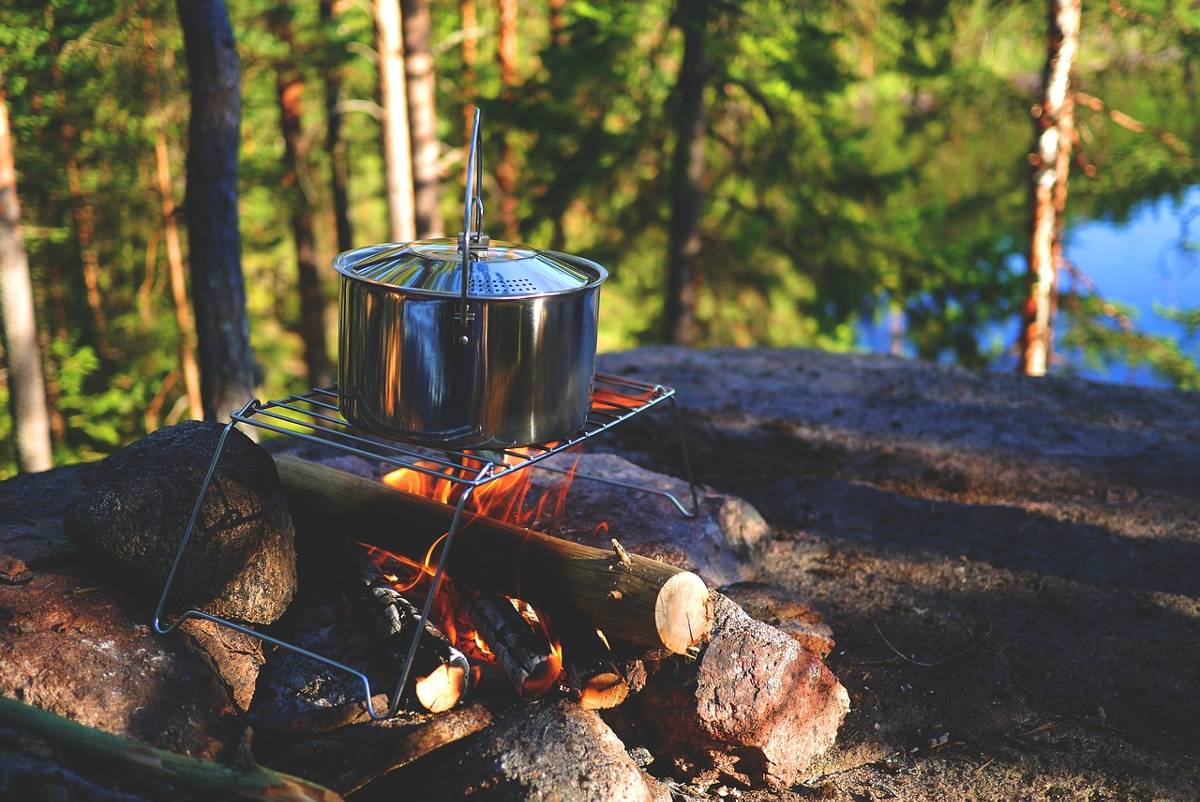Cooking over a campfire may seem intimidating, but it’s actually quite easy – and fun! With the right tools and a little bit of practice, you’ll be whipping up delicious meals in no time.
Whether you’re an experienced camper or just getting started, this guide will teach you how to cook over a campfire in just a few minutes. So grab your pots and pans and let’s learn how to cook over a campfire the right way!
For those who are new to camping and don’t think they have what it takes to create gourmet meals outdoors, rest assured that anyone can learn how to cook over a fire.
It doesn’t take expensive equipment or complicated recipes; all you need is some basic supplies, like matches or lighter fluid for starting the fire, sturdy utensils for stirring food while it cooks, and plenty of ingredients fresh from nature’s pantry.
But before we dive into discussing techniques and recipes for cooking over a campfire, there are several safety precautions to keep in mind. We’ll go over these guidelines so everyone can feel comfortable as they master their outdoor-cooking skills. Now that we’ve got the basics covered, let’s start learning about how to cook amazing dishes out in the wild!
1. Gather Necessary Cooking Supplies
Whether it’s roasting marshmallows or preparing a gourmet meal, knowing how to cook over a campfire is an essential skill for any camper.
The first step in learning how to cook over a campfire is gathering your tools and supplies.
Here’s a list of supplies you’ll want to consider taking to cook on a campfire:
- A fire starter kit: You’ll need something to light your fire, whether it’s matches, a lighter, or a flint and steel. You’ll also need some kindling and tinder to get your fire going. You can use dry leaves, twigs, paper, or cotton balls soaked in petroleum jelly as tinder. Kindling can be small sticks or branches that catch fire easily.
- Fuel: You’ll need some wood or charcoal to keep your fire burning. Wood gives your food a nice smoky flavor, but charcoal burns longer and more evenly. You can also use briquettes or coals that are specially made for campfire cooking. Make sure you have enough fuel for the duration of your trip and follow the fire safety rules of your campsite.
- A grill rack or tripod: You’ll need something to hold your pots and pans over the fire. A grill rack is a metal grate that you can place over the fire pit or on some rocks around it. A tripod is a metal stand with three legs that you can hang your pots and pans from using hooks or chains. Both options allow you to adjust the height and distance of your cookware from the fire.
- Cast iron cookware: Cast iron is one of the best materials for campfire cooking because it can withstand high temperatures and distribute heat evenly. You’ll need a large cast iron skillet for frying, sautéing, and baking foods like bacon, eggs, pancakes, potatoes, cornbread, etc. You’ll also need a cast iron Dutch oven for making soups, stews, chili, etc. Cast iron pots and pans are heavy and durable but they require proper seasoning and care.
- Sticks and skewers: If you want to roast some marshmallows or hot dogs over the fire (and who doesn’t?), you’ll need some sticks or skewers to hold them. You can use wooden skewers that are soaked in water beforehand to prevent burning or metal skewers that are more sturdy and reusable. You can also find some long sticks around your campsite but make sure they are clean and dry before using them.
- Tongs and wooden spoon: These are essential tools for moving food around on your grill rack or tripod as well as stirring ingredients in your pots and pans. Tongs are also useful for moving briquettes and coals into position under your cookware. A wooden spoon is better than metal because it won’t scratch your cast iron surface or conduct heat as much.
- Meat thermometer: You’ll need to make sure that your meat is cooked thoroughly enough so no one gets sick when you’re out enjoying your camping trip.
- Plates, bowls, cups, cutlery: Unless you want to eat directly from your pots and pans (which is totally fine), you’ll need some plates, bowls, cups, and cutlery to serve and enjoy your food and drinks. You can use disposable ones that are easy to pack and throw away or reusable ones that are more eco-friendly but require washing after each use.
If you’re going on a multi-day trip, don’t forget extra pots, pans, and utensils so you can have multiple meals in a row.
Once you have what you need, it’s time to prepare your campfire – soon enough you’ll be enjoying delicious meals cooked over your own roaring campfire!
2. Prepare Your Fire
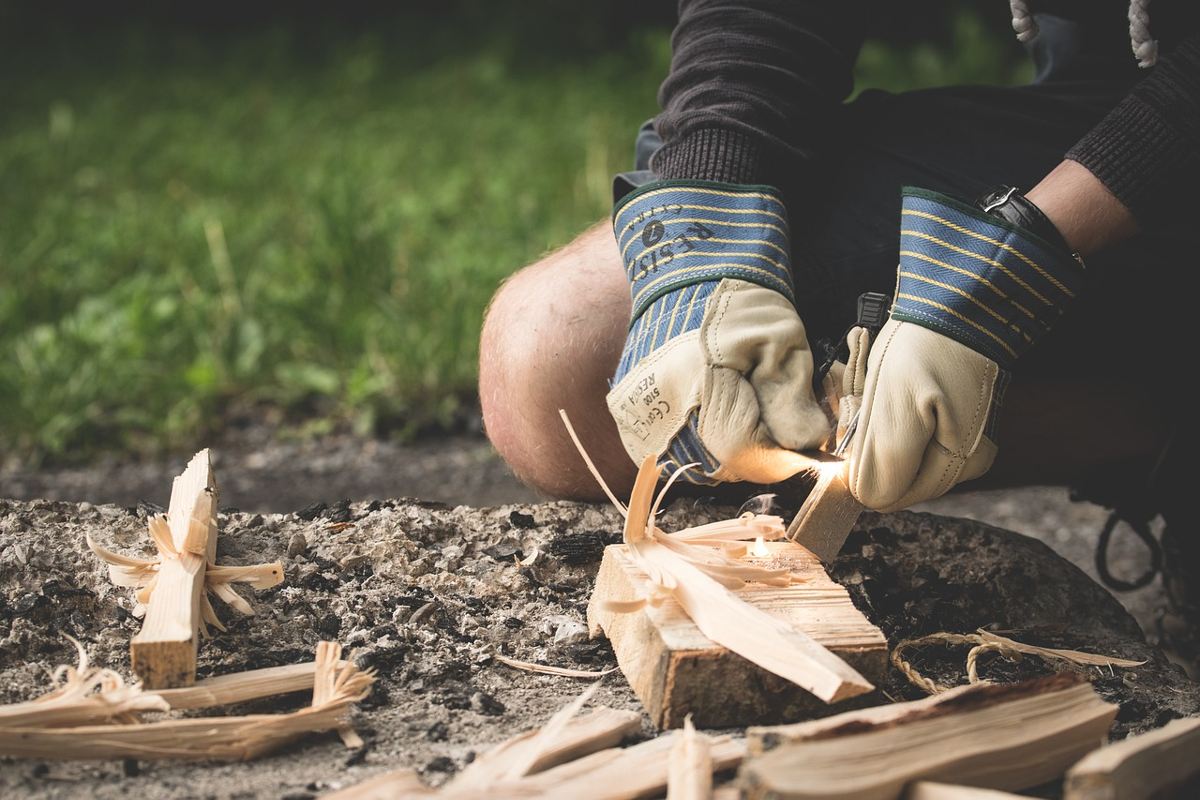

A good campfire starts with the right kindling. Before you can begin cooking over a campfire, you must prepare the fire and get it burning nicely.
First things first: gather your tinder, kindling and logs for the fire. Tinder should be dry leaves or grasses that will catch on fire easily when exposed to sparks from a lighter or match; twigs no thicker than a pencil make up the kindling, which will help maintain heat of the flame once ignited; finally, logs of various sizes are needed to keep the fire going.
Once all materials have been gathered together in one spot near your camping site, you can start building your fire. Start by creating a “teepee” structure out of small sticks and tinder at its center – this is where you will light your initial flame.
When you’ve got it lit, add more tinder and then gradually build up layers of larger pieces of kindling around it until it has enough fuel to grow into an actual blaze.
Finally, add some slightly bigger logs – keeping them off direct contact with flames – and adjust as necessary so that they don’t smother existing embers.
With patience and practice, soon enough you’ll have created yourself a nice bed of hot coals perfect for any outdoor meal!
3. Choose Your Cooking Method
When deciding how to cook over a campfire, the cooking method you choose can make all the difference. For example, take my friend Sarah and her family who recently went camping in Yosemite National Park. They wanted to enjoy some delicious meals while they were there, so they decided to bring along their trusty Dutch oven. After setting up the fire with plenty of wood, Sarah got to work pre-heating the Dutch oven before filling it with ingredients for their dinner.
Another great option is using skewers and grilling food directly over an open flame. This works especially well if you want something simple like hot dogs or burgers for lunch or dinner.
It’s also a nice way to get that smoky flavor into your food without having to use too much fuel from your firewood supply. Plus, it only takes minutes depending on what type of food item you’re grilling!
No matter which cooking method you decide on, be sure to keep safety in mind at all times when working around an open flame. Make sure children are supervised whenever possible and never leave burning embers unattended since they could cause accidental fires in dry conditions.
TIP: If things start getting out of hand due to strong winds or sparks flying everywhere, it may be best just put out the fire completely until conditions improve again. With this in mind, you’ll soon have delicious meals cooked over a campfire safely – no problem!
4. How to Cook Food Over a Campfire
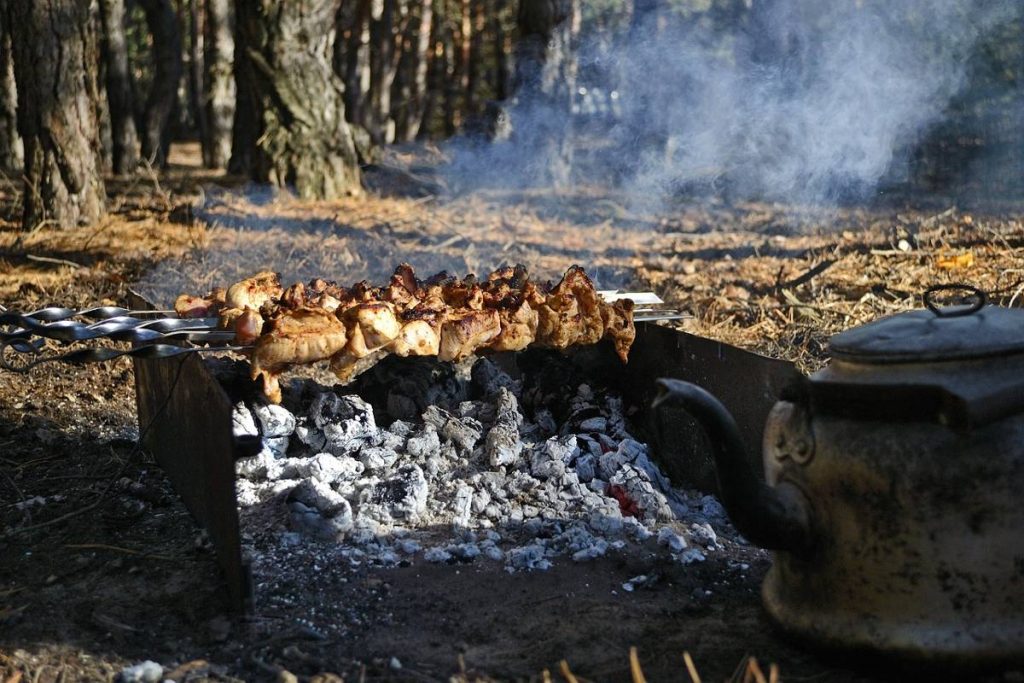

Cooking meat over a campfire requires special attention to ensure that it is cooked safely. It’s important to make sure the food reaches its safe minimum internal temperature, as determined by the USDA Safe Minimum Internal Temperature Chart:
| Product | Minimum Internal Temperature & Rest Time |
|---|---|
| Beef, Pork, Veal & Lamb Steaks, Chops, Roasts | 145 °F (62.8 °C) and allow to rest for at least 3 minutes |
| Ground Meats | 160 °F (71.1 °C) |
| Ground Poultry | 165 °F |
| Ham, fresh or smoked (uncooked) | 145 °F (62.8 °C) and allow to rest for at least 3 minutes |
| Fully Cooked Ham (to reheat) | Reheat cooked hams packaged in USDA-inspected plants to 140 °F (60 °C) and all others to 165 °F (73.9 °C). |
| All Poultry (breasts, whole bird, legs, thighs, wings, ground poultry, giblets, and stuffing) | 165 °F (73.9 °C) |
| Eggs | 160 °F (71.1 °C) |
| Fish & Shellfish | 145 °F (62.8 °C) |
| Leftovers | 165 °F (73.9 °C) |
| Casseroles | 165 °F (73.9 °C) |
Use a thermometer to check that any poultry has reached an internal temperature of at least 165°F and ground beef or pork should reach at least 160°F.
Try to avoid cross-contamination between raw and cooked foods by using separate utensils and cutting boards for each type of food.
Here are some easy meats you can cook on a campfire for a main dish:
- Hot dogs: You can skewer them on a stick or a metal fork and roast them over the fire until they are browned and hot. Serve them on buns with your favorite toppings like ketchup, mustard, relish, cheese, etc.
- Burgers: You can shape ground beef into patties and season them with salt, pepper, garlic powder, etc. Then grill them on a grate over the fire until they are cooked through. Flip them once halfway through. Serve them on buns with lettuce, tomato, onion, cheese, etc.
- Chicken: You can marinate chicken pieces in a ziplock bag with your favorite sauce like barbecue, teriyaki, honey mustard, etc. Then grill them on a grate over the fire until they are done. Turn them occasionally and baste them with more sauce if needed.
- Steak: You can season steak with salt, pepper, garlic powder, etc. and let it rest at room temperature for about 15 minutes. Then grill it on a grate over the fire until it reaches your desired doneness. Flip it once halfway through. Let it rest for another 5 minutes before slicing and serving.
- Fish: First, you need to clean and gut your fish, but leave the skin on. Then, rub some oil or butter on the fish and sprinkle some salt, pepper, or your favorite spices. You can also add some garlic, onion, or herbs for extra flavor. Next, place some lemon slices on top of the fish and wrap it tightly in foil. Place the foil packet on a cooking grate over hot coals and cook for about 15 minutes or until the fish flakes easily with a fork.
- Foil packets: You can make foil packets by wrapping your choice of meat and vegetables in aluminum foil with some butter or oil and seasonings. For example, you can use chicken breast or thighs with potatoes, carrots, onion, and rosemary; or salmon fillets with zucchini, squash, and lemon slices; or ground beef with corn kernels, green beans, and cheese. Then place the packets on a grate over the fire and cook for about 20 to 30 minutes or until the meat is done and the vegetables are tender.
When grilling over an open fire, keep in mind that you’ll need to turn your food regularly with tongs or a spatula to ensure even cooking. If possible, use skewers when cooking small pieces of meat such as kebabs so they don’t fall through the grates of the grill. Also, be mindful to not overcrowd your grill — this will help prevent flare-ups from excess fat dripping onto the flames!
Lastly, allow extra time for cooking since heat levels can vary greatly on an open flame. This will help guarantee that your meats are cooked thoroughly without burning them. As you move on to cook vegetables and sides, keep these tips in mind for a successful feast around the campfire!
5. Cook Vegetables and Sides


Do you want to make your campfire meal extra special? To elevate it with some delicious sides, read on!
When cooking vegetables and sides over a campfire, the goal is to keep them as close to their natural state as possible. This means that steaming or boiling in water prior to placing them directly onto the fire may be necessary for certain vegetables.
Alternatively, foil-packets are also an effective way of ensuring even heat distribution from the coals. It’s important not to overcrowd the pan or grate so that each vegetable can cook evenly without burning. Adding herbs and spices will give a unique flavor and boost nutrition.
There are endless possibilities when preparing simple yet tasty side dishes for a camping trip; however, prepping ahead of time is key since most ingredients should already be pre-cooked before added to the campfire.
Here are some easy to make sides you can cook over your campfire to accompany your meal:
- Corn on the cob: You can wrap corn ears in foil with some butter, salt and pepper and place them on the grill or near the coals. They will be ready in about 15 to 20 minutes, depending on how hot your fire is. You can also peel back the husks and roast them directly over the flames for a charred flavor.
- Baked potatoes: You can bake potatoes in foil with some oil, salt and your favorite herbs. Place them on the grill or near the coals and cook for about 40 to 60 minutes, turning occasionally, until they are soft inside. You can top them with cheese, sour cream, bacon bits or anything you like.
- Roasted carrots: You can cut carrots into thin slices or sticks and toss them with some oil, salt, pepper and honey. Wrap them in foil and place them on the grill or near the coals. Cook for about 25 to 35 minutes, until they are tender and caramelized.
- Grilled zucchini: You can slice zucchini into thin rounds or planks and brush them with some oil, salt, pepper and garlic powder. Place them directly on the grill or on a skewer and cook for about 10 to 15 minutes, turning once or twice, until they are charred and soft.
- Campfire nachos: You can layer tortilla chips, shredded cheese, black beans, salsa, corn kernels and jalapeños in a large cast iron skillet or a disposable aluminum pan. Cover it with foil and place it on the grill or over the coals. Cook for about 10 to 15 minutes, until the cheese is melted and bubbly. You can garnish it with sour cream, guacamole or cilantro.
Consider slicing up bell peppers and onions together with sausage links for a hearty fajita mix or mixing potatoes with butter, garlic salt, pepper and cheese wrapped in tinfoil creating yummy cheesy potato packets. With these tips in mind, creating fun meals around the campfire has never been easier!
6. Cook Desserts And Treats


When it comes to campfire cooking, desserts and treats can be a great way to end the meal. There are plenty of options for tasty treats that you can make over the fire. Here’s a list of five ideas:
- Toasted marshmallows – These classic treats are easy to cook up over an open flame. Just stick your marshmallow on a skewer and hold it over the heat until it’s golden brown all around.
- Pie iron pizzas – Make fun little sandwiches with these special tools designed for use in flames. All you have to do is assemble your sandwich ingredients inside two slices of bread, then close the pie iron and set it near or over the fire until everything melts together perfectly!
- Campfire cones – Fill sugar ice cream cones with fruit, chocolate chips or mini marshmallows before wrapping them in foil and setting them near the coals of your fire. After just 10 minutes you’ll have delicious treat-filled pockets ready for eating!
- Banana boats – This one involves cutting bananas down the middle and filling them with various goodies such as melted chocolate chips, nuts and dried fruits. Wrap each banana boat in foil and place them right onto hot embers until they’ve warmed through.
- Dutch oven cakes – For something more extravagant, why not bake up some cake using a cast iron Dutch oven? Mix up your favorite cake batter at home before packing everything into one big container which you can bring along with you to camp. Place your dough filled pot straight onto hot coals, cover with additional coals on top, wait 20 minutes and voila! Deliciousness awaits!
No matter what type of dessert or treat you decide on making over your campfire, always remember safety first when playing with flames; this applies especially if there are young children present who may need extra supervision during meal time activities.
Taking care to clean up after yourself is also important so that nothing remains behind once everyone has departed from the campsite area.
7. Clean Up Your Area
Part of the camping lifestyle is being respectful of nature and the land that you’re getting to camp and cook on. Here’s how to make sure you’re cleaning up your cooking space properly:
- Remove any food scraps from your cookware and utensils and dispose of them properly. Do not leave them in the fire pit or around your campsite as they can attract animals and insects.
- Wash your cookware and utensils with water and a stiff brush or rag. You can use wood ash from the fire pit as a natural soap. Mix some ash with water to make a paste and scrub your cookware with it. Rinse well with clean water.
- Dry your cookware and utensils thoroughly before storing them away. You can place them over the fire for a few minutes to evaporate any moisture. If you have cast iron cookware, you may need to season it with oil after drying it to prevent rusting.
- Let the fire die down completely before leaving your campsite. Do not pour water over the fire as it can create steam that can burn you or damage your fire pit. Instead, spread out the coals and ashes with a shovel or stick and let them cool down naturally.
- Transfer the cooled coals and ashes to a metal bucket or container with a lid using a shovel or scoop. Wet them down with water to make sure they are completely extinguished. Do not dump them on the ground or in a trash bin as they can still ignite other materials.
- Dispose of the coals and ashes safely according to local regulations or guidelines. You may be able to compost them, use them as fertilizer for your plants, or take them home with you for disposal in your regular garbage bin. Do not leave them at your campsite or in nature as they can harm wildlife and vegetation.
- Collect and bag all trash at the campsite and store it away for when you are ready to leave.
Cleaning up after you’ve cooked over a campfire can be tedious work, but leaving the site as you found it ensures that nature stays beautiful for future generations.
Plus, if you leave nothing behind but footprints, other visitors won’t know how delicious your s’mores were! In addition to being considerate of others, this will also help keep animals away from potential hazards such as plastic wrappers and glass containers.
So do yourself (and everyone else) a favor by taking the time to clean up after enjoying some tasty treats around the fire.
8. Campfire Food Recipes
Here are some popular and tasty campfire food recipes to try out on your next adventure, with ingredients, cooking methods, and estimated cooking times:
| Recipe Name | Ingredients | Method | Estimated Cooking Time |
|---|---|---|---|
| Campfire hot dogs | Hot dogs, buns, condiments | Skewer the hot dogs and hold over fire | 5 – 10 minutes |
| Foil wrapped potatoes | Potatoes, butter, salt, pepper, aluminum foil | Wrap potatoes in foil and place on hot coals | 20 – 30 minutes |
| Campfire stew | Diced meat, vegetables, herbs, broth, aluminum foil | Combine ingredients in foil pouch, place on hot coals | 40 – 50 minutes |
| Grilled corn on the cob | Corn with husk, butter, salt | Place corn with husk directly on grate over fire, turn occasionally | 15 – 20 minutes |
| Skillet scrambled eggs | Eggs, salt, pepper, butter, cheese (optional) | Heat skillet on grate, add ingredients and stir | 10 – 15 minutes |
| S’mores | Marshmallows, chocolate, graham crackers | Roast marshmallows and sandwich between crackers with chocolate | 5 – 10 minutes |
| Banana boat desserts | Bananas, mini marshmallows, chocolate chips, aluminum foil | Slit banana, stuff with marshmallows and chocolate, wrap in foil and place on coals | 10 – 15 minutes |
Frequently Asked Questions
Review some of the most frequently asked questions about campfire cooking.
What Type Of Fuel Should I Use For My Campfire?
Have you ever wondered what type of fuel is best to use when cooking over a campfire? It’s an important question, and one that warrants further investigation. While there are many theories about which kind of fuel should be used for fire-based cooking, the answer ultimately depends on the individual situation.
In general, it can be said that wood should be your primary source for a campfire. Not only does burning wood provide good heat and smoke for flavorful meals, but it also has a low environmental impact compared to other fuels like propane or charcoal.
If you’re looking for something more efficient than logs, try using sticks and twigs as tinder to get your flames going quickly. For larger fires requiring longer burn times, opt for dry hardwood logs such as oak or hickory. As well as providing plenty of fuel, they will also add great aromas to any food cooked over them!
When gathering materials to build your fire with, always keep safety in mind: never gather wet wood (which produces thick clouds of smoke) or green branches (which create too much creosote).
Make sure you have enough air flow around the fire – this helps maintain a consistent temperature so your meal cooks evenly without charring. To achieve this airflow consider trying out different combinations with crisscrossed logs and stones arranged into a teepee shape.
It may take some practice before you master the art of building an efficient camping fire but once you do it’ll become second nature! Plus having the knowledge at hand means that no matter where you find yourself – from beach bonfires to backyard barbecues – you’ll know exactly how to light up delicious dishes safely and effectively.
What Are Some More Recipes I Can Make Over A Campfire?
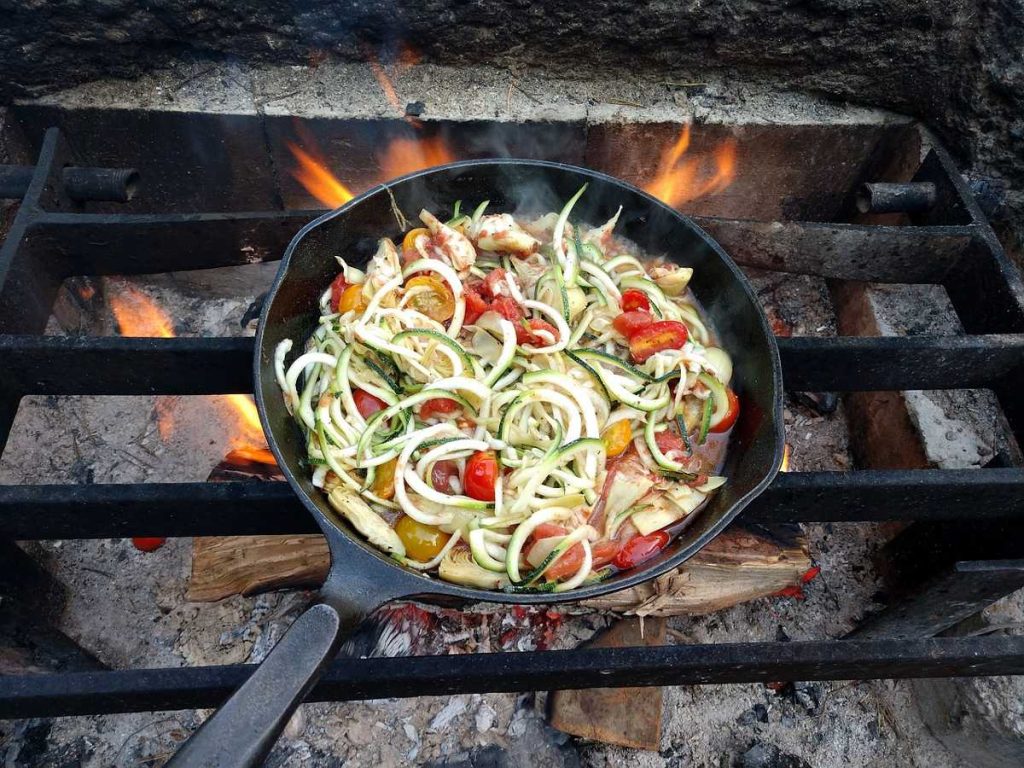

From classic campfire recipes like foil-wrapped potatoes or chili dogs, to creative options such as breakfast burritos, caramel apples or gourmet grilled cheese sandwiches, there’s no limit to what you can cook on a campfire.
Forget fast food dinners under neon lights; why not gather up family and friends around a cozy campfire and enjoy some truly unforgettable outdoor dining?
Here’s some more interesting dishes you can consider cooking up on your next trip out:
- Pizza Mountain Pies: Use bread, pizza sauce, cheese, pepperoni, and butter to make delicious pizza sandwiches in a pie iron over the fire.
- Foil-Pack Stew: Combine beef stew meat, potatoes, carrots, onion soup mix, water, and butter in a foil packet and cook on hot coals until tender.
- Campfire Bean ‘N’ Ham Soup: Simmer canned beans, ham, onion, celery, chicken broth, barbecue sauce, and seasonings in a Dutch oven over the fire for a hearty soup.
- Campin’ Philly Cheesesteak Sandwiches: Cook sliced steak, onion, green pepper, garlic salt, and pepper in a skillet over the fire. Then add cheese slices and spoon onto hoagie rolls.
- Dutch-Oven Campfire Pizza: Make pizza dough from scratch or use refrigerated dough. Spread it in a greased Dutch oven and top with sauce, cheese, pepperoni, and any other toppings you like. Cover with lid and bake over hot coals until crust is golden.
How Can I Keep My Food From Burning Over The Campfire?
Cooking over a campfire can be a fun and rewarding experience, but it can also be challenging and frustrating if you don’t know how to avoid burning your food.
No one likes to eat charred marshmallows, blackened burgers, or scorched eggs. So how can you keep your food from burning over the campfire?
Whether you are using a grill grate, a pot, a foil packet, or an orange peel, you will learn how to control the temperature, prevent flare-ups, and reheat leftovers safely and easily.
The real key is to pay close attention the entire time while cooking — that means adjusting the heat of the fire so it’s not too hot or using indirect heat rather than direct exposure.
If things start getting too warm, move items away from the center of the flame. And for added protection against flare-ups, consider keeping some water nearby in case you need to douse any sudden sparks.
But even with these precautions, don’t forget about timing: watch your food carefully and turn it frequently as needed.
It might take some time to get used to this type of cooking but with patience and practice – and maybe a few burnt bits of food later – you’ll be able to find success at your next campfire gathering!
How Do I Make Sure My Food Is Cooked Through Over A Campfire?
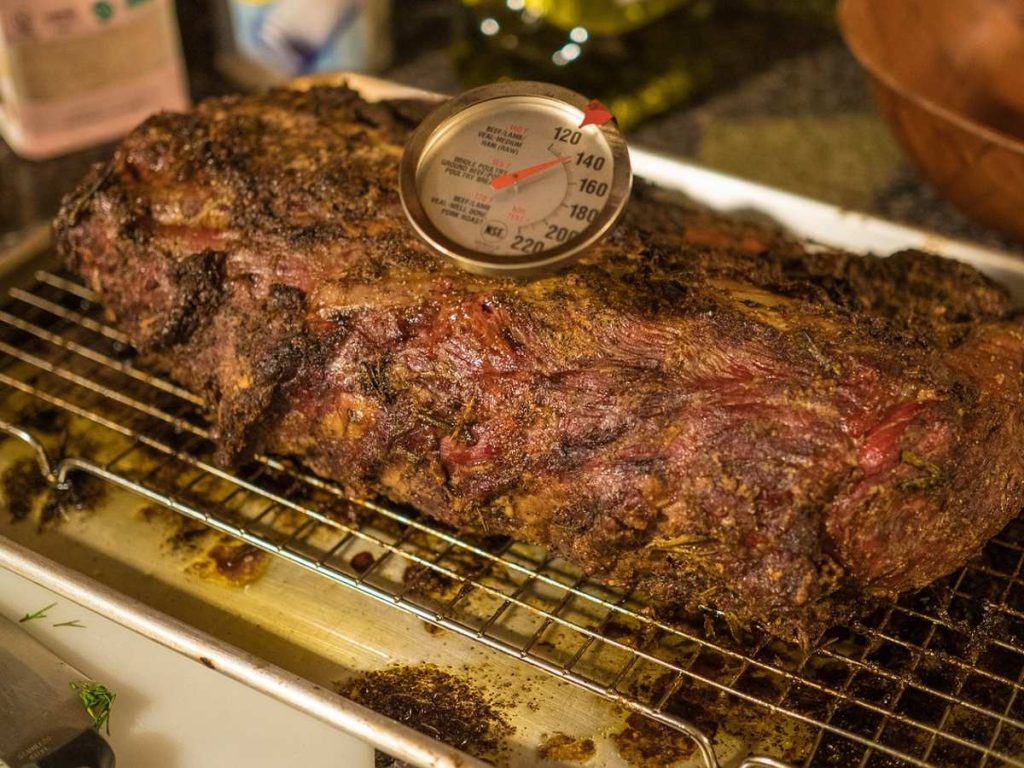

To ensure that your food is cooked through, there are several things you need to keep in mind while cooking.
Pay attention to heat levels – too low, and your food will take forever; too high, and you’ll end up with charcoal instead of delicacies!
Monitor the temperature as you cook by carefully observing how quickly or slowly the fire is burning. You should also adjust accordingly based on what type of dish you’re preparing.
Using proper cookware is essential for successful campfire cooking. Choose items that are made from materials such as cast iron or stainless steel which can handle higher temperatures without breaking down easily. Make sure that they have handles so that they’re easy to move around when necessary.
Here are some tips to help you cook your food properly:
- Find cookware pieces which are durable enough to withstand higher temperatures
- Look for pots and pans with long handles so they don’t get too close to the flames
- Invest in good-quality utensils specifically designed for use over a campfire
- Always carry an accurate analog or digital thermometer with you
Practice makes perfect! Before setting out on your camping trip, try experimenting with different recipes at home using similar conditions as those found outdoors – this way you can hone your skills before attempting more complex dishes under pressure.
Are There Any Safety Tips I Should Keep In Mind While Cooking Over A Campfire?
Campfires can be unpredictable and dangerous if not handled properly, so it’s important to take the necessary precautions while cooking outdoors. Here are some tips to help ensure your food is cooked safely:
Make sure you have an adequate fire pit that will contain any embers or sparks. It’s wise to keep a bucket of water nearby in case of emergency as well.
Use long BBQ tongs or sticks when handling hot objects like metal skewers or pans – this helps avoid potential burns from popping coals and sparks.
Pay attention to what foods you bring camping – canned goods should go with you in the car instead of being stored near the fire due to their combustible nature.
You’ll also want to check for safe temperatures on perishable items such as meat before putting them directly onto the flames; undercooking meals could lead to food poisoning.
Establish rules about who will tend the fire throughout the night and keep an eye out for curious kids around the area at all times – children should always remain supervised near open fires.
Conclusion
Cooking over a campfire is an enjoyable and rewarding experience. There’s something magical about the firelight, laughter of friends and family, and the smell of delicious food cooking in the night air.
The key to successful campfire cooking is finding the right fuel, selecting recipes that are easy to make over a fire, monitoring your food while it cooks so you don’t burn it, being aware of how long items need to cook for, and following safety guidelines when working with open flames. With these tips in mind, I’m confident anyone can become a true campfire chef!
So get out there and start grilling!
Nothing beats gathering around a warm campfire as dusk sets in and enjoying a home-cooked meal – no matter what kind of fuel you use or recipe you choose. It’s sure to be an unforgettable experience for everyone involved.
